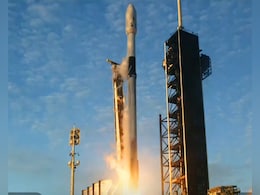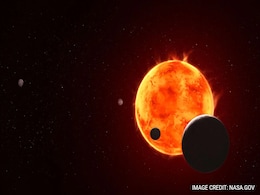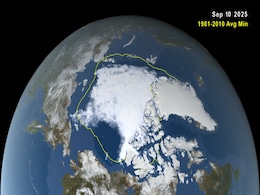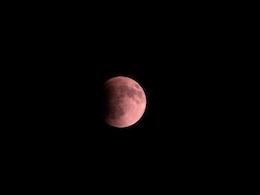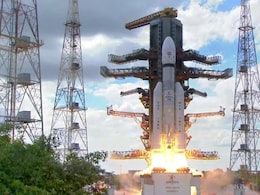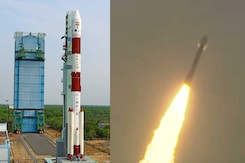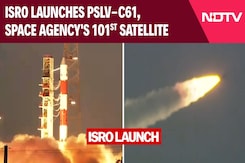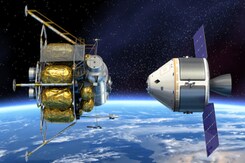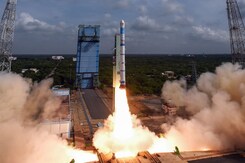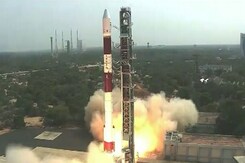Earth Observation
- All
- News
- Videos
- Web Stories
-

Asteroid 2024 YR4: Earth Safe, but New Data Shows Small 2032 Lunar Impact Risk
- Monday November 24, 2025
- Written by Gadgets 360 Staff
Asteroid 2024 YR4 has been cleared as an Earth threat, but updated observations show a small chance it could hit the Moon in 2032. Space agencies are monitoring the asteroid closely, expecting new data to narrow uncertainties and determine whether the lunar-impact probability will drop or rise.
-
 www.gadgets360.com
www.gadgets360.com
-

Comet Similar To Interstellar Object 3I/ATLAS Fast Moving Towards Earth
- Wednesday November 12, 2025
- Science | Edited by NDTV News Desk
Astronomers have observed a mysterious comet racing through the solar system towards both Earth and the Sun. It has led to comparisons with the famous interstellar object 3I/ATLAS.
-
 www.ndtv.com
www.ndtv.com
-

Scientist Claims Alien Probes May Be In Plain Sight, Observing Earth's Growing Intelligence
- Tuesday November 11, 2025
- Science | Edited by Astitva Raj
Ellery suggested that building a nuclear reactor on the Moon could yield chemical signatures that could be explored in the future.
-
 www.ndtv.com
www.ndtv.com
-

Hubble Observes Massive Stellar Eruption from EK Draconis, Hinting at Life’s Origins
- Sunday November 2, 2025
- Written by Gadgets 360 Staff
Astronomers using the Hubble Space Telescope observed a huge solar storm from EK Draconis, a young Sun-like star. The eruption’s energy may trigger atmospheric chemistry, forming greenhouse gases and organic molecules. Such events could mirror early solar activity that helped spark life on ancient Earth and distant exoplanets.
-
 www.gadgets360.com
www.gadgets360.com
-

SpaceX Launches IMAP, CGO, SWFO-L1 to Probe Solar Frontier and Space Weather
- Sunday September 28, 2025
- Written by Gadgets 360 Staff
A Falcon 9 lifted off from Kennedy Space Center on Sept. 24, 2025, carrying NASA’s IMAP, CGO, and SWFO-L1 spacecraft. The mission aims to chart the heliosphere’s boundary, monitor Earth’s geocorona, and deliver constant space-weather alerts, protecting satellites and astronauts while expanding knowledge of the solar system’s outer edge.
-
 www.gadgets360.com
www.gadgets360.com
-

Earth’s Oxygen Explains Mysterious Rust Formation on the Moon
- Sunday September 28, 2025
- Written by Gadgets 360 Staff
Despite lacking air and water, the Moon hosts hematite—an oxidized iron mineral. Scientists discovered Earth’s escaping oxygen drives this rusting process during the Moon’s passage through the magnetotail. Observations from Chandrayaan-1 and NASA’s Lunar Reconnaissance Orbiter confirm hematite patches where Earth wind suppresses hydrogen an...
-
 www.gadgets360.com
www.gadgets360.com
-

Not Like Venus Or Mars, Distant Exoplanet May Have Atmosphere Like Earth's
- Friday September 19, 2025
- World News | Edited by NDTV News Desk
A distant exoplanet might have an atmosphere similar to Earth's, early observations from the James Webb Space Telescope (JWST) suggest. It is part of a group of planets orbiting a star called TRAPPIST-1, about 40 light-years away from Earth.
-
 www.ndtv.com
www.ndtv.com
-

Satellite Observations Record Arctic Sea Ice at Lowest Level of the Year
- Sunday September 21, 2025
- Written by Gadgets 360 Staff
NASA satellites recorded Arctic sea ice at 1.78 million sq miles on Sept. 10, 2025—its tenth-lowest extent. Antarctic ice also stayed below seasonal averages. Scientists stress these lows reflect long-term climate-driven changes reshaping Earth’s polar regions.
-
 www.gadgets360.com
www.gadgets360.com
-

400 Scientists Worked Continuously During Operation Sindoor: ISRO Chief
- Tuesday September 9, 2025
- India News | Press Trust of India
More than 400 scientists worked round-the-clock to provide support using earth observation and communication satellites during Operation Sindoor, ISRO chairperson V Narayanan said on Tuesday.
-
 www.ndtv.com
www.ndtv.com
-

'Blood Moon' Rises, Rare Total Lunar Eclipse Lights Up The Sky
- Sunday September 7, 2025
- India News | Edited by NDTV News Desk
Stargazers were in for a treat as they turned their gaze towards the Moon Sunday night to witness a rare 'Blood Moon' or the total lunar eclipse, the longest since 2022, visible acrossAsia and swathes of Europe and Africa.
-
 www.ndtv.com
www.ndtv.com
-

India's Start-Ups Go Big, 12-Satellite Earth Observation Constellation Soon
- Friday August 29, 2025
- India News | Reported by Pallava Bagla
In a defining moment for India's space ambitions, four private companies -- Pixxel, Piersight, Satsure, and Dhruva Space -- have joined forces to build a 12-satellite Earth observation constellation, nick-named 'Prithvi Drishti'.
-
 www.ndtv.com
www.ndtv.com
-

Powerful Space Telescope Observes Interstellar Object, Finds CO2 And Water
- Wednesday August 27, 2025
- Science | Edited by Srishti Singh Sisodia
NASA explained that the object has been categorised as interstellar because of the hyperbolic shape of its orbital path.
-
 www.ndtv.com
www.ndtv.com
-

India's 15-Year Space Plan: 103 Satellites, Chandrayaan-8, Indian On Moon
- Sunday August 24, 2025
- India News | Reported by Pallava Bagla
India is preparing for a transformative leap in space exploration and satellite technology.
-
 www.ndtv.com
www.ndtv.com
-

NASA-ISRO Earth Observation Satellite Unfolds Giant Radar Antenna in Space
- Tuesday August 19, 2025
- Written by Gadgets 360 Staff
NASA and ISRO’s joint NISAR mission has successfully deployed its 12-meter radar reflector in orbit. This unique satellite, carrying dual L-band and S-band radars, will monitor Earth’s glaciers, volcanoes, earthquakes, and ecosystems with unmatched accuracy. The milestone reflects decades of research and showcases the strength of U.S.-India spa...
-
 www.gadgets360.com
www.gadgets360.com
-

Asteroid 2024 YR4: Earth Safe, but New Data Shows Small 2032 Lunar Impact Risk
- Monday November 24, 2025
- Written by Gadgets 360 Staff
Asteroid 2024 YR4 has been cleared as an Earth threat, but updated observations show a small chance it could hit the Moon in 2032. Space agencies are monitoring the asteroid closely, expecting new data to narrow uncertainties and determine whether the lunar-impact probability will drop or rise.
-
 www.gadgets360.com
www.gadgets360.com
-

Comet Similar To Interstellar Object 3I/ATLAS Fast Moving Towards Earth
- Wednesday November 12, 2025
- Science | Edited by NDTV News Desk
Astronomers have observed a mysterious comet racing through the solar system towards both Earth and the Sun. It has led to comparisons with the famous interstellar object 3I/ATLAS.
-
 www.ndtv.com
www.ndtv.com
-

Scientist Claims Alien Probes May Be In Plain Sight, Observing Earth's Growing Intelligence
- Tuesday November 11, 2025
- Science | Edited by Astitva Raj
Ellery suggested that building a nuclear reactor on the Moon could yield chemical signatures that could be explored in the future.
-
 www.ndtv.com
www.ndtv.com
-

Hubble Observes Massive Stellar Eruption from EK Draconis, Hinting at Life’s Origins
- Sunday November 2, 2025
- Written by Gadgets 360 Staff
Astronomers using the Hubble Space Telescope observed a huge solar storm from EK Draconis, a young Sun-like star. The eruption’s energy may trigger atmospheric chemistry, forming greenhouse gases and organic molecules. Such events could mirror early solar activity that helped spark life on ancient Earth and distant exoplanets.
-
 www.gadgets360.com
www.gadgets360.com
-

SpaceX Launches IMAP, CGO, SWFO-L1 to Probe Solar Frontier and Space Weather
- Sunday September 28, 2025
- Written by Gadgets 360 Staff
A Falcon 9 lifted off from Kennedy Space Center on Sept. 24, 2025, carrying NASA’s IMAP, CGO, and SWFO-L1 spacecraft. The mission aims to chart the heliosphere’s boundary, monitor Earth’s geocorona, and deliver constant space-weather alerts, protecting satellites and astronauts while expanding knowledge of the solar system’s outer edge.
-
 www.gadgets360.com
www.gadgets360.com
-

Earth’s Oxygen Explains Mysterious Rust Formation on the Moon
- Sunday September 28, 2025
- Written by Gadgets 360 Staff
Despite lacking air and water, the Moon hosts hematite—an oxidized iron mineral. Scientists discovered Earth’s escaping oxygen drives this rusting process during the Moon’s passage through the magnetotail. Observations from Chandrayaan-1 and NASA’s Lunar Reconnaissance Orbiter confirm hematite patches where Earth wind suppresses hydrogen an...
-
 www.gadgets360.com
www.gadgets360.com
-

Not Like Venus Or Mars, Distant Exoplanet May Have Atmosphere Like Earth's
- Friday September 19, 2025
- World News | Edited by NDTV News Desk
A distant exoplanet might have an atmosphere similar to Earth's, early observations from the James Webb Space Telescope (JWST) suggest. It is part of a group of planets orbiting a star called TRAPPIST-1, about 40 light-years away from Earth.
-
 www.ndtv.com
www.ndtv.com
-

Satellite Observations Record Arctic Sea Ice at Lowest Level of the Year
- Sunday September 21, 2025
- Written by Gadgets 360 Staff
NASA satellites recorded Arctic sea ice at 1.78 million sq miles on Sept. 10, 2025—its tenth-lowest extent. Antarctic ice also stayed below seasonal averages. Scientists stress these lows reflect long-term climate-driven changes reshaping Earth’s polar regions.
-
 www.gadgets360.com
www.gadgets360.com
-

400 Scientists Worked Continuously During Operation Sindoor: ISRO Chief
- Tuesday September 9, 2025
- India News | Press Trust of India
More than 400 scientists worked round-the-clock to provide support using earth observation and communication satellites during Operation Sindoor, ISRO chairperson V Narayanan said on Tuesday.
-
 www.ndtv.com
www.ndtv.com
-

'Blood Moon' Rises, Rare Total Lunar Eclipse Lights Up The Sky
- Sunday September 7, 2025
- India News | Edited by NDTV News Desk
Stargazers were in for a treat as they turned their gaze towards the Moon Sunday night to witness a rare 'Blood Moon' or the total lunar eclipse, the longest since 2022, visible acrossAsia and swathes of Europe and Africa.
-
 www.ndtv.com
www.ndtv.com
-

India's Start-Ups Go Big, 12-Satellite Earth Observation Constellation Soon
- Friday August 29, 2025
- India News | Reported by Pallava Bagla
In a defining moment for India's space ambitions, four private companies -- Pixxel, Piersight, Satsure, and Dhruva Space -- have joined forces to build a 12-satellite Earth observation constellation, nick-named 'Prithvi Drishti'.
-
 www.ndtv.com
www.ndtv.com
-

Powerful Space Telescope Observes Interstellar Object, Finds CO2 And Water
- Wednesday August 27, 2025
- Science | Edited by Srishti Singh Sisodia
NASA explained that the object has been categorised as interstellar because of the hyperbolic shape of its orbital path.
-
 www.ndtv.com
www.ndtv.com
-

India's 15-Year Space Plan: 103 Satellites, Chandrayaan-8, Indian On Moon
- Sunday August 24, 2025
- India News | Reported by Pallava Bagla
India is preparing for a transformative leap in space exploration and satellite technology.
-
 www.ndtv.com
www.ndtv.com
-

NASA-ISRO Earth Observation Satellite Unfolds Giant Radar Antenna in Space
- Tuesday August 19, 2025
- Written by Gadgets 360 Staff
NASA and ISRO’s joint NISAR mission has successfully deployed its 12-meter radar reflector in orbit. This unique satellite, carrying dual L-band and S-band radars, will monitor Earth’s glaciers, volcanoes, earthquakes, and ecosystems with unmatched accuracy. The milestone reflects decades of research and showcases the strength of U.S.-India spa...
-
 www.gadgets360.com
www.gadgets360.com






